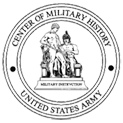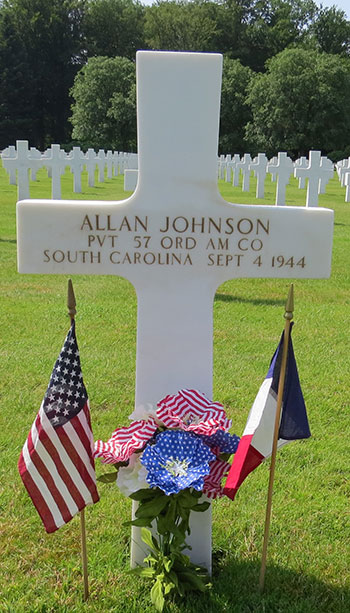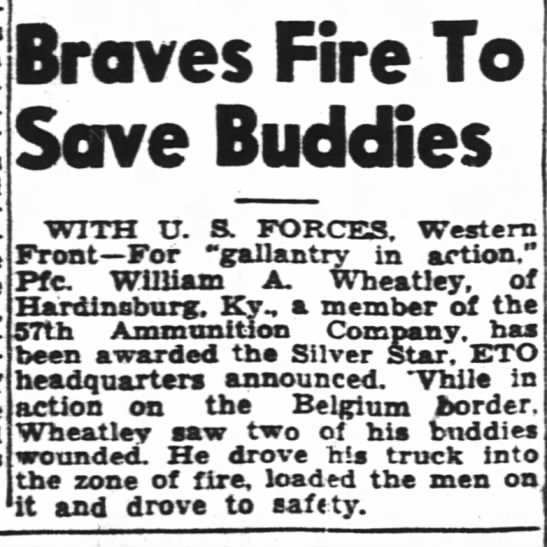
57th Ordnance Ammunition Company

Headstone of Private Allan Johnson who was killed in action and buried in the Epinal American Cemetery in France
Killing or capturing enemy soldiers, braving heavy fire on multiple occasions, conducting reconnaissance, recapturing ammunition which was vital to ultimate Allied victory during the Battle of the Bulge, and earning Purple Hearts and awards for valor—these actions might sound like the accomplishments of a combat arms unit during World War II, perhaps an infantry company whose main purpose was to directly engage the enemy. Instead, it is the history of an ordnance company whose main mission was to manage ammunition supply points. Far from being behind the scenes or away from battle, the 57th Ordnance Ammunition Company, an African-American unit, was often in the thick of the action during 1944 and 1945. The story is this unit is largely unknown, buts it valor and achievements suggest that the history of the 57th Ordnance Ammunition Company deserves a wider audience.
The 57th Ordnance Company was first activated at Raritan Arsenal, New Jersey, for a six-month period in 1921. It was activated again with African-American personnel under the command of a white officer at Savanna Ordnance Depot, Illinois, on 6 February 1941, and relocated to Camp Blanding, Florida, in June 1941. The unit participated in maneuvers and training in Louisiana and South Carolina. On 1 April 1942, the unit was redesignated as the 57th Ordnance Ammunition Company.1
On 12 November 1943, the 57th Ordnance Ammunition Company sailed from New York aboard the troopship Andes, arriving in England on 20 November.2 The company was stationed in Faringdon, Berkshire, England until 7 June 1944, when it transferred to Hursley on the south coast in preparation for movement into France. From June 1944 until the the surrender of Nazi Germany in May 1945, the company was attached to the 100th Ordnance Battalion.
The company arrived in France by 6:00 p.m. on 12 June 1944. Under “light German artillery fire,” the 57th set up an ammunition supply point, or ASP, inland from the beachhead near Balleroy, France. It was the first ASP established to support V Corps units and the first of many ammunition supply points which the 57th Ordnance Ammunition Company would create and manage over the next several months. On 21 June 1944, after an increase in German artillery fire and “enemy aircraft activity,” the ASP was evacuated to a new location about five miles to the rear, with 1500 tons of ammunition moved in five hours by Ordnance Corps vehicles. Over the next several months, the 57th advanced through Europe with U.S. forces. The 57th established temporary ASPs near Nonancourt and Pontoise, France.3
On 4 September 1944, the 57th Ordnance Ammunition Company encountered enemy troops (identified as members of the “22nd Panzer Grenadier Division” in the unit history of the 100th Ordnance Battalion) near Drancourt, France, in the Somme region near the Belgian border. Being the only Allied unit in the immediate vicinity, the 57th engaged the German troops who were ensconced in several buildings. Using small arms fire, the 57th killed either 39 or 50 enemy troops (numbers vary according to different reports) and captured the rest (about 15 men). Private Allan Johnson was killed in action, and Private Howard Ellison, Jr. was wounded in this engagement. Both were awarded Purple Hearts. Johnson was buried in the Epinal American Cemetery in Dinozé, France. Private William A. Wheatley was awarded a Silver Star and the French Croix de Guerre for his actions during this engagement, and Technical Sergeant Harold F. Jackson was awarded a Bronze Star and a Croix de Guerre. 1st Lieutenant Donald Aitken was also awarded a Croix de Guerre.4 On 24 February 1945, the African-American newspaper Pittsburgh Courier reported on Wheatley’s Silver Star, noting that William A. Wheatley, of Hardinsburg, Kentucky, had driven a truck into the zone of fire, loaded his two wounded battle buddies (likely Johnson and Ellison) onto it, and evacuated them.5 On 10 February 1945, the same newspaper had reported on TSgt. Harold F. Jackson’s Bronze Star, noting that Jackson had crawled under fire towards a barn where German troops were sheltering and tossed in an incendiary grenade, forcing the Germans out of the barn so that the 57th could pick them off.6
Having proved itself under fire, the 57th Ordnance Ammunition Company opened Ammunition Supply Point 118 in the area it had cleared of enemy troops. Within days, the unit had moved on, establishing ASPs in Belgium near Tirlemont and Waimes. On 17 December 1944, a day after the start of the German counteroffensive known as the Battle of the Bulge, the ASP near Waimes was threatened by the advance of German forces. Under orders to destroy certain types of ammunition which “would readily be of use to the enemy,” men of the 57th prepared items for demolition within 45 minutes. With the enemy about a mile away, the demolition was carried out in haste, but “personnel, ASP records, and major items of equipment” were “evacuated without loss.” The following day, Captain Jack Carstarphen, commander of the 57th Ordnance Ammunition Company, and unit members 1st Lieutenant Arnold Putnam, Master Sergeant Chester McKinney (the ranking NCO member of the unit), and Private First Class Daniel Barber attempted to conduct reconnaissance on the buildings they had evacuated. Putnam and Barber were surprised by two German soldiers, but both managed to run away despite being fired upon. CPT Carstarphen, hearing the fire, located and killed the two Germans with a submachine gun. All four members of the 57th returned safely to the unit.7

According to The Ordnance Department: On Beachhead and Battlefront, “[E]very day a detachment of one officer and twenty enlisted men from the 57th [Ordnance] Ammunition Company was able to return [to the evacuated ASP at Waimes] and issue ammunition from one end of the ASP, although it was under artillery and machine gun fire. There is a story that while the Americans were issuing at one end, the Germans were issuing at the other.”8 On 12 February 1945, the Portsmouth Herald of Portsmouth, New Hampshire, ran an article in which a U.S. Army colonel attributed Germany’s ultimate failure in the Battle of Bulge to U.S. Army Ordnance Soldiers who safeguarded American vehicles and ammunition from capture. The article contained the following quotation: “At one ammunition supply point where ordnancemen were beginning to clear out on the first day of the breakthrough, there continued to be fighting in one section of the ammunition storage area while in a nearby section ordnancemen of the 57th ordnance ammunition company [sic] continued to issue as much as possible of the remaining stock. The commanding officer of this unit, Capt. Jack C. Carstraphen [sic] of Fort Worth, Tex., found his Negro ammunition men working by some infantry mortar squads who were surrounded by more rounds of 60-mm and 81-mm ammunition than they could ever hope to shoot.”9
In early January 1945, the 57th operated an ammunition supply point at Sprimont, Belgium, “to support XVIII Corps in their drive against the northern flank of the bulge.” The volume of ammunition handled over the next two weeks was so heavy that two Quartermaster companies were brought in to help, allowing for nighttime operations. Heavy snow drifts created difficulties by covering ammunition stacks. On 8 February 1945, the 57th opened ASP 136 to support VII Corps. In one month, this ASP handled 27,394 tons of ammunition.
After III Corps crossed the Rhine River, the 57th Ordnance Ammunition Company was dispatched to set up a new ammunition supply point near Rheinbach, Germany, on 9 March 1945. There they encountered new challenges: “Enemy mine fields surrounded the installation and the fields had to be swept at least twenty yards on each side of the roads before they became suitable for storage.” Nonetheless, 525 trucks had been unloaded and 2,300 tons of ammunition delivered by the afternoon of 10 March. For the next few weeks, the 57th and other companies turned over an average of 3000 tons of ammunition per day from this ASP. Ammunition company personnel had to assist engineers in repairing a poor but heavily traveled road at the ASP.
In late March 1945, the 57th Ordnance Ammunition Company moved to support VII Corps’ crossing of the Rhine and its advance across Germany: “They came under shell fire for three days, but no damage to any ammunition resulted.” However, Private Joseph L. James of the 57th was wounded in action on 25 March 1945 and later awarded a Purple Heart. Because bridges were out, it was necessary to use convoy control points along the river for three days; nonetheless, 843 tons of ammunition per day were moved in the first five days.
From this point forward, the rapid advance of U.S. forces across Germany meant that supply points had to be established and moved quickly. In March and April 1945, 57th Ordnance Ammunition Company operated ASPs in Horbach and Gerlingen. By this time, the company had established and/or operated at least 14 ammunition supply points in mainland Europe.10 Members of the unit, often operating under difficult circumstances, safeguarded, moved, and supplied vital ammunition to the U.S. Army as it liberated Europe and secured Germany. They proved highly adaptable and braved gun and artillery fire, including their combat engagement with enemy forces on 4 September 1944. The 57th Ordnance Ammunition Company remained in Germany until 10 December 1946, when it was officially inactivated. The unit earned campaign participation credit for five World War II campaigns: Normandy, Northern France, Rhineland, Ardennes-Alsace, and Central Europe.11
On 26 July 1948, President Harry Truman issued Executive Order 9981, which stated that “there shall be equality of treatment and opportunity for all persons in the armed serves without regard to race, color, religion or national origin.”12 Over the next several years, U.S. Army units were desegregated. The 57th Ordnance Ammunition Company was redesignated as the 57th Ordnance Evacuation Company and activated 15 January 1948 at Fort Knox, Kentucky. The unit served in the Korean War from 1950 to 1953 and earned a Republic of Korea Presidential Unit Citation. Over time and under various designations, the unit also served in Okinawa, Thailand, and again in Germany. The unit has been inactive since 15 December 1991.13
Sources
1 Adjutant General’s Office unit data card for the 57th Ordnance Ammunition Company.
2Ibid
3 LTC Alfred G. Garr, Unit History, 100th Ordnance Battalion (Ammunition), May 11, ’42 – May 9, ’45, 11 May 1945, pp. 19, 23, 35, 41, 42, and 87.
4 Ibid, pp. 42, 115, 116; American Battle Monuments Commission website, https://www.abmc.gov/database-search (accessed 10 February 2017); Ulysses Lee, The Employment of Negro Troops (Washington, DC: Center of Military History, 1966), p. 641. Lee cites Report, 261st Ordnance Battalion, 1944.
5 “Braves Fire to Save Buddies,” The Pittsburgh Courier, 24 February 1945, p. 1.
6“Sergeant Gets Bronze Star for Action in Belgium,” The Pittsburgh Courier, 10 February 1945, p. 2.
7Garr, Unit History, 100th Ordnance Battalion (Ammunition), pp. 42, 45, 51, 58, and 59.
8 Lida Mayo, The United States Army in World War II: The Technical Services: The Ordnance Department: On Beachhead and Battlefront, (Washington, DC: Center of Military History, 1968), p. 309.
9“Von Rundstedt Lost Out When He Couldn’t Grab Supplies, Says Officer,” The Portsmouth Herald (Portsmouth, New Hampshire), 12 February 1945, p. 2.
10Garr, Unit History, 100th Ordnance Battalion (Ammunition), pp. 65, 67, 68, 71, 72, 74, 97, 98, 115, and 116.
11Adjutant General’s Office unit data card for the 57th Ordnance Ammunition Company; and Lineage and Honors of the 57th Maintenance Company, 30 January 1990, U.S. Army Center of Military History.
12President Harry S. Truman, Executive Order 9981, website of the Harry S. Truman Library and Museum, National Archives and Records Administration, http://www.trumanlibrary.org/9981.htm (accessed 10 February 2017).
13Adjutant General’s Office unit data card for the 57th Ordnance Ammunition Company, U.S. Army Center of Military History.
